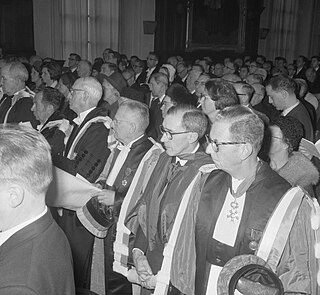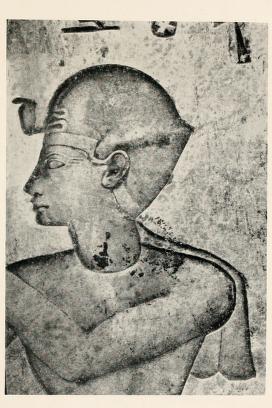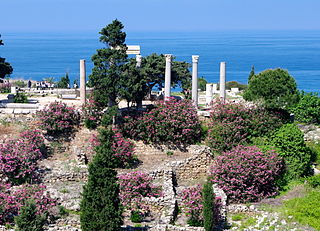
Saqqara, also spelled Sakkara or Saccara in English, is an Egyptian village in the markaz (county) of Badrashin in the Giza Governorate, that contains ancient burial grounds of Egyptian royalty, serving as the necropolis for the ancient Egyptian capital, Memphis. Saqqara contains numerous pyramids, including the Pyramid of Djoser, sometimes referred to as the Step Tomb, and a number of mastaba tombs. Located some 30 km (19 mi) south of modern-day Cairo, Saqqara covers an area of around 7 by 1.5 km.

Tanis or San al-Hagar is the Greek name for ancient Egyptian ḏꜥn.t, an important archaeological site in the northeastern Nile Delta of Egypt, and the location of a city of the same name. It is located on the Tanitic branch of the Nile, which has long since silted up.

Titkheperure or Tyetkheperre Psusennes II [Greek Ψουσέννης] or Hor-Pasebakhaenniut II [Egyptian ḥr-p3-sb3-ḫˁỉ-⟨n⟩-nỉwt], was the last king of the Twenty-first Dynasty of Egypt. His royal name means "Image of the transformations of Re" in Egyptian. Psusennes II is often considered the same person as the High-Priest of Amun known as Psusennes III. The Egyptologist Karl Jansen-Winkeln notes that an important graffito from the Temple of Abydos contains the complete titles of a king Tyetkheperre Setepenre Pasebakhaenniut Meryamun "who is simultaneously called the HPA and supreme military commander." This suggests that Psusennes was both king at Tanis and the High Priest in Thebes at the same time, meaning he did not resign his office as High Priest of Amun during his reign. The few contemporary attestations from his reign include the aforementioned graffito in Seti I's Abydos temple, an ostracon from Umm el-Qa'ab, an affiliation at Karnak and his presumed burial – which consists of a gilded coffin with a royal uraeus and a Mummy, found in an antechamber of Psusennes I's tomb at Tanis. He was a High Priest of Amun at Thebes and the son of Pinedjem II and Istemkheb. His daughter Maatkare B was the Great Royal Wife of Osorkon I.

Menkheperre, son of Pinedjem I by wife Duathathor-Henuttawy, was the High Priest of Amun at Thebes in ancient Egypt from 1045 BC to 992 BC and de facto ruler of the south of the country.

Tomb WV23, also known as KV23, was the tomb of Ay, a pharaoh of the Eighteenth Dynasty, in the Western Valley of the Kings near modern-day Luxor. The tomb was discovered in 1816 by Giovanni Battista Belzoni. Its architecture is similar to that of the royal tomb of Akhenaten at Amarna, with a straight descending corridor leading to a "well chamber" that has no shaft. This leads to the burial chamber, which now contains the reconstructed sarcophagus, which was smashed in antiquity. The tomb had also been anciently desecrated, with many instances of Ay's image or name erased from the wall paintings. Its decoration is similar in content and colour to that of the tomb of Tutankhamun (KV62), with a few differences. On the eastern wall there is a depiction of a fishing and fowling scene, which is not shown in other royal tombs, normally appearing in burials of nobility.

Tomb WV22, also known as KV22, was the burial place of Amenhotep III, a pharaoh of the Eighteenth Dynasty, in the western arm of the Valley of the Kings. The tomb is unique in that it has two subsidiary burial chambers for the pharaoh's wives Tiye and Sitamen. It was officially discovered in August 1799 by Prosper Jollois and Édouard de Villiers du Terrage, engineers with Napoleon's expedition to Egypt but had probably been open for some time. The tomb was first excavated in the early 1900s by Theodore M. Davis; the details of this are lost. The first documented clearance was carried out by Howard Carter in 1915. Since 1989, a Japanese team from Waseda University led by Sakuji Yoshimura and Jiro Kondo has excavated and conserved the tomb. The sarcophagus is missing from the tomb. The tomb's layout and decoration follow the tombs of the king's predecessors, Amenhotep II (KV35) and Thutmose IV (KV43); however, the decoration is much finer in quality. Several images of the pharaoh's head have been cut out and can be seen today in the Louvre.

Psusennes I was the third pharaoh of the 21st Dynasty who ruled from Tanis between 1047 and 1001 BC. Psusennes is the Greek version of his original name Pasibkhanu or Pasebakhaenniut, which means "The Star Appearing in the City" while his throne name, Akheperre Setepenamun, translates as "Great are the Manifestations of Ra, chosen of Amun." He was the son of Pinedjem I and Henuttawy, Ramesses XI's daughter by Tentamun. He married his sister Mutnedjmet.

Heqakheperre Shoshenq II or Shoshenq IIa was a pharaoh of the Twenty-second Dynasty of Egypt. He was the only ruler of this dynasty whose tomb was not plundered by tomb robbers. His final resting place was discovered within an antechamber of Psusennes I's tomb at Tanis by Pierre Montet in 1939. Montet removed the coffin lid of Shoshenq II on March 20, 1939, in the presence of king Farouk of Egypt himself. It proved to contain many jewel-encrusted bracelets and pectorals, along with a beautiful hawkheaded silver coffin and a gold funerary mask. The facemask had been placed upon the head of the king. Montet later discovered the intact tombs of two Twenty-first Dynasty kings a year later in February and April 1940 respectively. Shoshenq II's prenomen, Heqakheperre Setepenre, means "The manifestation of Ra rules, the chosen one of Ra."

Usermaatre Amenemope was an ancient Egyptian pharaoh of the 21st Dynasty who ruled between 1001–992 BC or 993–984 BC.

Jean Pierre Marie Montet was a French Egyptologist.

Tomb KV45 is an ancient Egyptian tomb located in the Valley of the Kings in Egypt. It was originally used for the burial of the noble Userhet of the Eighteenth Dynasty and was reused by Merenkhons and an unknown woman in the Twenty-second Dynasty. The tomb was discovered and excavated by Howard Carter in 1902, in his role as Chief Inspector of Antiquities, on behalf of Theodore M. Davis. The tomb was later re-investigated by Donald P. Ryan of the Pacific Lutheran University Valley of the Kings Project in 1991 and 2005.

Neterkheperre or Netjerkheperre-Setepenamun Siamun was the sixth pharaoh of Egypt during the Twenty-first Dynasty. He built extensively in Lower Egypt for a king of the Third Intermediate Period and is regarded as one of the most powerful rulers of the Twenty-first Dynasty after Psusennes I. Siamun's prenomen, Netjerkheperre-Setepenamun, means "Divine is The Manifestation of Ra, Chosen of Amun" while his name means 'son of Amun.'

Masaharta or Masaherta was the High Priest of Amun at Thebes between 1054 and 1045 BC.

TT1 is the burial place of the ancient Egyptian official Sennedjem and members of his family in Deir el-Medina, on the west bank of the Nile opposite Luxor. The funerary complex consists of three pyramid-shaped chapels dedicated to, from south to north, Sennedjem's father or brother, Sennedjem himself, and to Sennedjem's son Khonsu. Of the three shafts associated with the chapels, only the shaft in front of Sennedjem's chapel was unrobbed. It led to a series of underground rooms, including the extensively decorated burial chamber.

Prince Hornakht was the son of pharaoh Osorkon II of the 22nd Dynasty. He was appointed by Osorkon II to the office of chief priest of Amun at Tanis to strengthen this king's authority in Lower Egypt. However, this was primarily a political move on Osorkon II's part since Hornakht died before the age of 10.

Duathathor-Henuttawy, Henuttawy or Henttawy("Adorer of Hathor; Mistress of the Two Lands") was an ancient Egyptian princess and later queen.
Mutnedjmet was an ancient Egyptian queen of the 21st Dynasty. She was the Great Royal Wife of her brother, Psusennes I.

Henuttawy or Henettawy, was an ancient Egyptian princess and priestess during the 21st Dynasty.
The Theban Tomb TT414 is located in El-Assasif, part of the Theban Necropolis, on the west bank of the Nile, opposite to Luxor. The tomb was originally constructed in the El-Assasif necropolis for the use of Ankh-hor and his family. Ankhor was the Chief Steward to the God's Wife Nitocris during the 26th Dynasty. Ankh-hor is dated to the reigns of Pharaohs Psamtik II and Apries. The tomb was later usurped during the 30th Dynasty and the Ptolemaic Period.

The royal necropolis of Byblos is a group of nine Bronze Age underground shaft and chamber tombs housing the sarcophagi of several kings of the city. Byblos is a coastal city in Lebanon, and one of the oldest continuously populated cities in the world. The city established major trade links with Egypt during the Bronze Age, resulting in a heavy Egyptian influence on local culture and funerary practices. The location of ancient Byblos was lost to history, but was rediscovered in the late 19th century by the French biblical scholar and Orientalist Ernest Renan. The remains of the ancient city sat on top of a hill in the immediate vicinity of the modern city of Jbeil. Exploratory trenches and minor digs were undertaken by the French mandate authorities, during which reliefs inscribed with Egyptian hieroglyphs were excavated. The discovery stirred the interest of western scholars, leading to systematic surveys of the site.





















